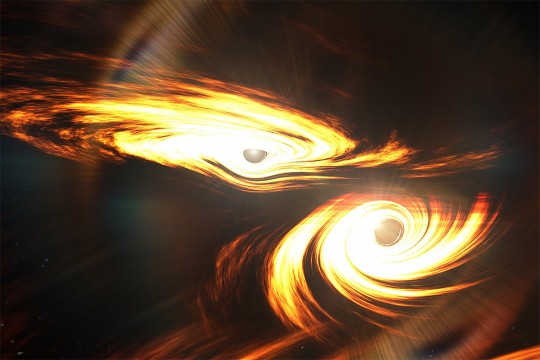News
Astrophysical Sciences and Technology MS
-
January 9, 2023
![four images of space with 13 insets showing greater detail of celestial elements.]()
James Webb Space Telescope study reveals wide diversity of galaxies in the early universe
New data from the James Webb Space Telescope (JWST) have revealed that the structures of galaxies in the early universe were much more diverse and mature than previously known. RIT Associate Professor Jeyhan Kartaltepe said that JWST’s ability to see faint high redshift galaxies in sharper detail than Hubble allowed the team of researchers to resolve more features and see a wide mix of galaxies.
-
August 29, 2022
![side-by-side images of the Jewel Bug Nebula, with the left showing purples and blues and the right showing reds, blues, and greens.]()
RIT scientists to study molecular makeup of planetary nebulae using radio telescopes
By using radio telescopes to study sun-like stars in their death throes, scientists hope to reveal important information about the origin of life-enabling chemicals in the universe. The NSF is awarding a $339,362 grant to a team led by Professor Joel Kastner to conduct such a study.
-
August 5, 2022
![Student and professor in lab, looking at computer screen]()
RIT student Lazar Buntic awarded NASA FINESST graduate student fellowship
RIT student Lazar Buntic received a earned a graduate research fellowship through the Future Investigators in NASA Earth and Space Science and Technology program to develop infrared detectors for next generation telescopes.
-
August 4, 2022
![image from a space telescope showing specks and blobs of differing sizes and colors.]()
RIT astrophysicists collaborate on JWST survey yielding wide view of the early universe
New images from NASA’s James Webb Space Telescope show what may be among the earliest galaxies ever observed. The images were taken from the Cosmic Evolution Early Release Science Survey (CEERS), led by a scientist at The University of Texas at Austin. Jeyhan Kartaltepe, an associate professor from RIT, is one of 18 co-investigators from 12 institutions along with more than 100 collaborators from the U.S. and nine other countries.
-
June 6, 2022
![an artist's impression of the view from a planet that may have formed in the disk of gas and dust orbiting a star.]()
RIT professor earns NASA grant to study baby stars and newborn planets closest to Earth
A team of RIT scientists is poring over NASA data for new insights about Earth’s youngest, closest neighbors. Joel Kastner, a professor in RIT’s Chester F. Carlson Center for Imaging Science and School of Physics and Astronomy, received nearly $400,000 for a NASA archival study to advance our understanding of newly formed stars and planets.
-
May 23, 2022
![portrait of student Olivia Young.]()
RIT student Olivia Young receives prestigious NSF Graduate Research Fellowship
Astrophysical sciences and technology Ph.D. student Olivia Young earned a competitive fellowship from the National Science Foundation to develop machine learning algorithms that will help scientists use radio telescopes to study transient objects such as pulsars and fast radio bursts.
-
January 20, 2022
![Artist’s impression of binary black holes about to collide.]()
RIT scientists confirm a highly eccentric black hole merger for the first time
For the first time, scientists believe they have detected a merger of two black holes with eccentric orbits. According to a paper published in Nature Astronomy by researchers from RIT and the University of Florida, this can help explain how some of the previous black hole mergers are much heavier than previously thought possible.
-
December 16, 2021
![artists rendering of the James Webb Space Telescope.]()
Multiple RIT scientists contribute to the newest space telescope
When the James Webb Space Telescope (JWST) launches, it will mark the culmination of nearly 30 years of development on the most powerful observational instrument ever made. Numerous members of RIT’s College of Science have been involved in its creation or will work on projects once it becomes operational.
-
December 6, 2021
![the Vela pulsar, a rapidly rotating neutron star.]()
RIT scientists develop machine learning techniques to shed new light on pulsars
New machine learning techniques developed by scientists at Rochester Institute of Technology are revealing important information about how pulsars—rapidly rotating neutron stars—behave. In a new study published by Monthly Notices of the Royal Astronomical Society, the researchers outlined their new techniques and how they applied to study Vela, the brightest radio pulsar in the sky.
-
November 16, 2021
![student wearing hard hat and clean suit working on rocket equipment.]()
RIT astrophysics graduate students conduct experiment at White Sands Missile Range
Serena Tramm and Mike Ortiz are pursuing their studies in astrophysics and have been working alongside Michael Zemcov, assistant professor in RIT’s School of Physics and Astronomy. Together, the team conducted an experiment that resulted in traveling to New Mexico’s White Sands Missile Range for the first CIBER-2 launch earlier this year.
-
November 8, 2021
![chart showing 90 gravitational wave events.]()
LIGO-Virgo-KAGRA Collaboration announces 90 gravitational wave discoveries to date
The LIGO-Virgo-KAGRA Collaboration unveiled several studies that shed important new light on the nature of gravitational waves. They include a “census” of gravitational wave events to date and a new catalog of results from the second half of its third observing run.
-
October 4, 2021
![RIT astrophysical sciences and technology Ph.D. student Peter Craig.]()
Astrophysical sciences and technology Ph.D. student receives DOE award to study dark matter
RIT’s Peter Craig is one of 65 graduate students from 29 states to receive an award from the U.S. Department of Energy’s Office of Science Graduate Student Research (SCGSR) program. He will conduct research at Lawrence Berkeley National Laboratory.





















